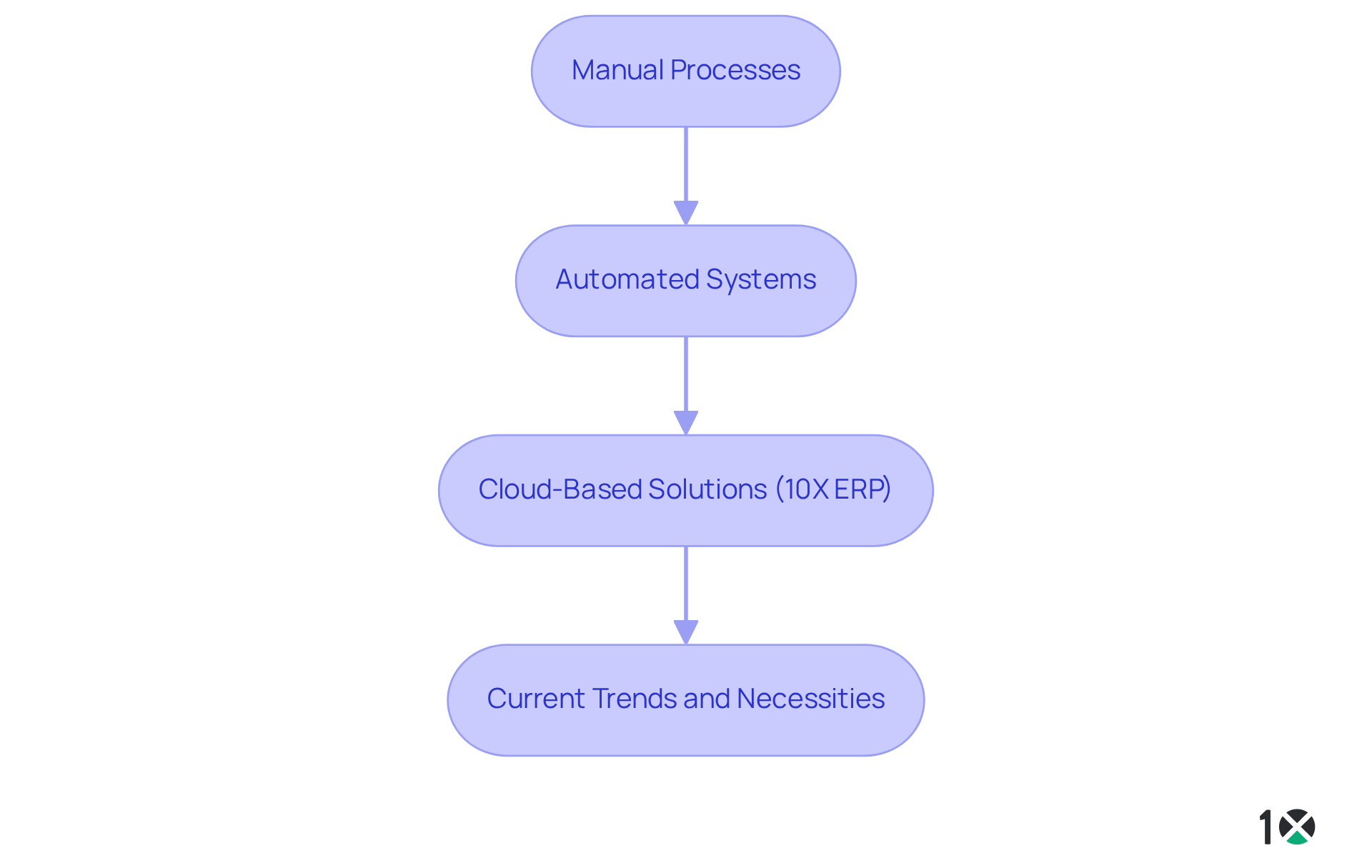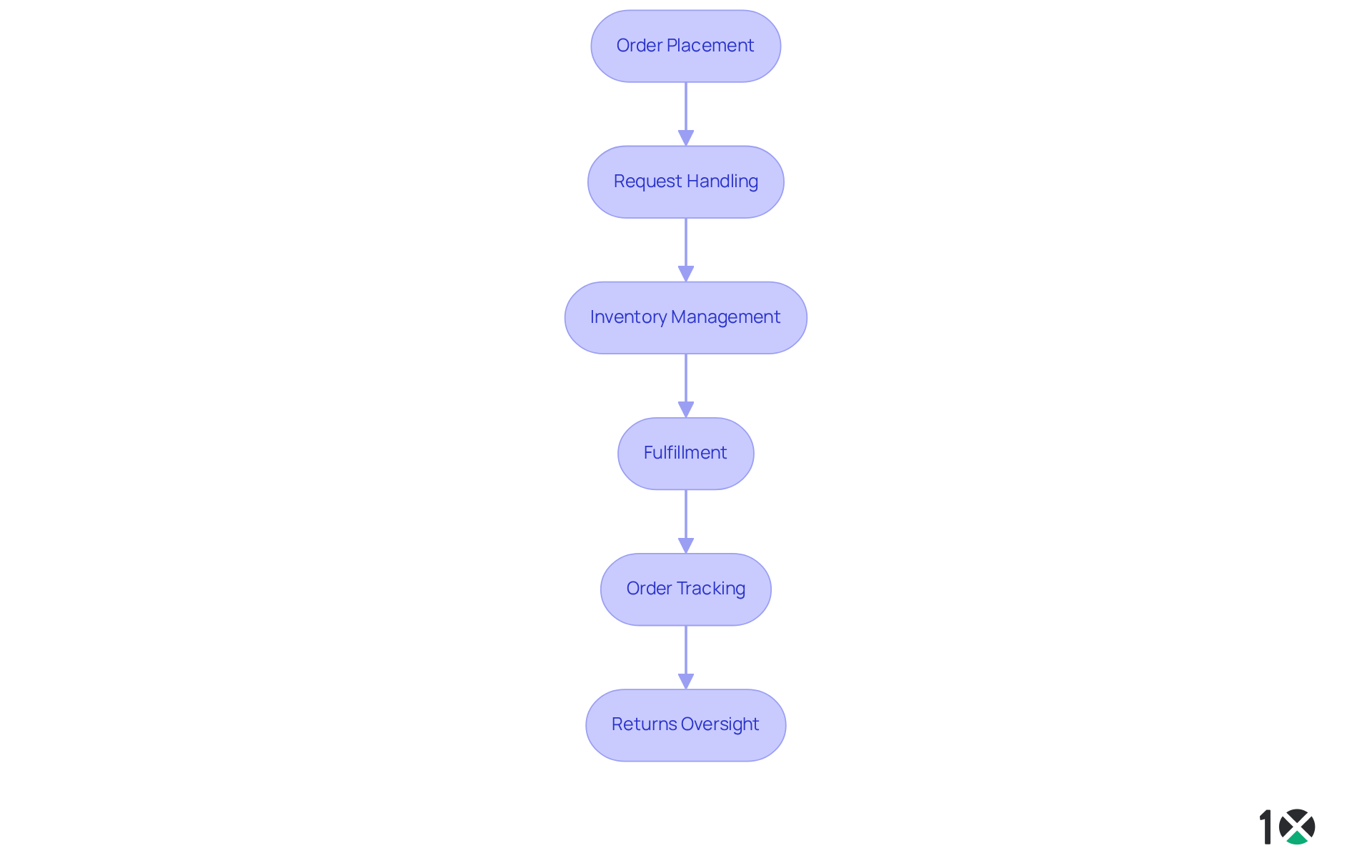Overview
The order management process for distributors is a systematic approach to handling client requests from placement to fulfillment, with a strong emphasis on efficiency and customer satisfaction. This article delineates critical stages, including:
- Order placement
- Inventory management
- Fulfillment
It underscores the role of integrated systems like 10X ERP in overcoming common challenges and enhancing operational performance through real-time data and automation. By understanding these processes, distributors can significantly improve their service delivery and operational efficiency.
Introduction
The order management process stands as a vital cog in the machinery of distribution, encompassing everything from initial client requests to the final delivery of products. As businesses strive to enhance customer satisfaction and streamline operations, understanding this process becomes essential.
However, with the rapid evolution of technology and shifting consumer expectations, distributors encounter a myriad of challenges that can hinder their efficiency.
How can they navigate these complexities to ensure seamless order fulfillment in an increasingly competitive landscape?
Define the Order Management Process
The stages of receiving, handling, and fulfilling client requests are all part of the order management process. The order management process encompasses every aspect from the moment a client submits a request to the final delivery of the product. This order management process is crucial for ensuring customer satisfaction and operational efficiency, as it directly influences inventory control, shipping logistics, and overall business performance. Efficient control systems, like the order management process, streamline these workflows, enabling companies to manage requests effectively and accurately.
With 10X ERP’s robust accounting functionalities—featuring real-time data handling, customizable inventory monitoring, and integrated reporting capabilities—distributors can significantly enhance their fulfillment workflows. The system’s adaptable user permissions, comprehensive audit trail, and reporting features further bolster decision-making, ensuring that stakeholders have the necessary information to manage requests effectively. This powerful combination not only improves the order management process but also enables companies to respond swiftly to client needs, ultimately driving satisfaction and loyalty.

Context and Evolution of Order Management
The system for handling requests has evolved significantly over the years, driven by advancements in technology and changing consumer expectations. Initially, inventory oversight relied heavily on manual processes, often employing paper-based systems that were prone to errors and inefficiencies. As technology emerged, companies began adopting automated systems that integrated processing with inventory management and customer relationship handling. Today, cloud-based solutions like 10X ERP are at the forefront, providing real-time data processing, flexible user permissions and roles, a robust audit trail, and integrated reporting that enhance the overall efficiency of the order management process.
10X ERP’s API-first approach facilitates seamless integrations with existing software, enabling distributors to respond swiftly to market fluctuations and customer demands. This transformation underscores the growing necessity for comprehensive solutions that not only streamline operations but also provide robust inventory oversight and data integrity, all while maintaining a transparent pricing structure and exceptional support. As the landscape continues to shift, embracing these advancements is crucial for staying competitive and meeting the evolving needs of the market.

Key Components and Stages of the Order Management Process
The order management process includes several critical components and stages that are essential for distributors to operate efficiently.
-
Order Placement: This initial stage involves clients submitting requests through various channels, including online platforms, phone calls, or in-person interactions. The ease of this process significantly influences customer satisfaction.
-
Request Handling: Following the receipt of a request, the processing phase commences, involving payment verification, inventory level checks, and preparation for fulfillment. On average, e-commerce shops spend 24-48 hours processing transactions before transferring them to carriers, underscoring the necessity for efficiency in this phase.
-
Inventory Management: Efficient inventory oversight is crucial for ensuring that required products are accessible to meet requests. This entails monitoring inventory levels and managing reorders to avoid stockouts, which can lead to lost sales and dissatisfied clients.
-
Fulfillment: This stage involves picking, packing, and shipping the order to the client. Efficient fulfillment is vital for timely delivery, as 67.77% of US shoppers value two-day shipping options when making online purchases. Introducing automation in fulfillment activities can reduce handling times by as much as 70%, thereby enhancing overall efficiency.
-
Order Tracking: Providing clients with real-time tracking features improves transparency and satisfaction. With 77% of online shoppers expecting delivery within two hours for certain products, effective tracking systems are essential for meeting these heightened expectations.
-
Returns Oversight: Managing returns effectively is a vital aspect of the fulfillment system, as it directly influences client loyalty and operational expenses. An easy returns system can greatly enhance client satisfaction and optimize warehouse operations.
Each of these phases is crucial for ensuring that the order management process functions seamlessly, ultimately fulfilling and surpassing client expectations in a competitive market.

Challenges in the Order Management Process
Despite advancements in technology, many distributors continue to face significant challenges within their fulfillment systems. These common issues can hinder operational efficiency and customer satisfaction:
-
Manual Errors: Relying on manual processes often leads to inaccuracies in data entry, inventory tracking, and fulfillment, ultimately resulting in customer dissatisfaction. 10X ERP mitigates this risk with its intuitive user interface and rapid onboarding, ensuring a streamlined order management process.
-
Inventory Discrepancies: Inaccurate inventory data can cause stockouts or overstocking, both detrimental to sales and consumer trust. With 10X ERP’s best-in-class inventory management features and real-time data processing, distributors can maintain accurate inventory levels, thereby enhancing customer satisfaction.
-
Complexity of Multichannel Sales: Managing requests from various sales channels can create confusion and inefficiencies, especially without integrated systems. 10X ERP offers seamless API integrations, enabling effective management of requests across different platforms and streamlining processes for distributors.
-
Slow Fulfillment Times: Delays in processing and shipping orders can lead to lost sales and damaged customer relationships. The rapid performance of 10X ERP ensures that requests are handled promptly, preserving strong customer ties.
-
Returns Management: Inefficient handling of returns can be both cumbersome and costly, negatively impacting overall profitability. 10X ERP’s comprehensive support and ongoing product enhancements equip distributors with the necessary tools to manage returns effectively, ultimately boosting profitability.
Moreover, the transparent pricing model of 10X ERP allows distributors to understand the value they receive, facilitating informed investment in a robust system for order processing. Addressing these challenges necessitates a strategic approach, including the adoption of powerful order management processes like 10X ERP, which seamlessly integrate with other business processes.

Conclusion
The order management process stands as a vital component for distributors, encompassing every step from the initial client request to the final product delivery. Effectively managing this process enables companies to enhance customer satisfaction, streamline operations, and maintain a competitive edge in the market. The evolution of order management systems, particularly through advancements in technology, has transformed traditional manual methods into efficient, automated solutions that cater to the dynamic needs of modern consumers.
Key insights from the article underscore the stages of order management, including:
- Order placement
- Request handling
- Inventory management
- Fulfillment
- Order tracking
- Returns oversight
Each phase plays a critical role in ensuring a seamless workflow, addressing common challenges such as manual errors, inventory discrepancies, and slow fulfillment times. The introduction of robust systems like 10X ERP illustrates how technology can mitigate these issues, equipping distributors with the necessary tools for accurate data handling and efficient operations.
Ultimately, embracing modern order management solutions is essential for distributors aiming to thrive in an ever-evolving landscape. By investing in effective systems that enhance operational efficiency and customer experience, businesses can not only meet but exceed client expectations, fostering loyalty and driving growth. The significance of a well-structured order management process cannot be overstated; it serves as the backbone of a successful distribution strategy that ensures long-term sustainability and competitiveness in the market.
Frequently Asked Questions
What is the order management process?
The order management process includes the stages of receiving, handling, and fulfilling client requests, starting from the moment a client submits a request to the final delivery of the product.
Why is the order management process important?
It is crucial for ensuring customer satisfaction and operational efficiency, as it directly influences inventory control, shipping logistics, and overall business performance.
How does an efficient order management process benefit companies?
An efficient order management process streamlines workflows, enabling companies to manage requests effectively and accurately, which enhances overall operational performance.
What features does 10X ERP offer to improve the order management process?
10X ERP offers robust accounting functionalities, real-time data handling, customizable inventory monitoring, and integrated reporting capabilities to enhance fulfillment workflows.
How do user permissions and reporting features in 10X ERP contribute to order management?
The system’s adaptable user permissions and comprehensive audit trail support decision-making, ensuring that stakeholders have the necessary information to manage requests effectively.
What is the impact of improved order management on customer satisfaction?
By enhancing the order management process, companies can respond swiftly to client needs, ultimately driving customer satisfaction and loyalty.
